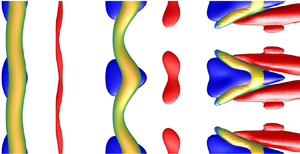Article contents
Nonlinear input/output analysis: application to boundary layer transition
Published online by Cambridge University Press: 26 January 2021
Abstract

We extend linear input/output (resolvent) analysis to take into account nonlinear triadic interactions by considering a finite number of harmonics in the frequency domain using the harmonic balance method. Forcing mechanisms that maximise the drag are calculated using a gradient-based ascent algorithm. By including nonlinearity in the analysis, the proposed frequency-domain framework identifies the worst-case disturbances for laminar-turbulent transition. We demonstrate the framework on a flat-plate boundary layer by considering three-dimensional spanwise-periodic perturbations triggered by a few optimal forcing modes of finite amplitude. Two types of volumetric forcing are considered, one corresponding to a single frequency/spanwise wavenumber pair, and a multi-harmonic where a harmonic frequency and wavenumber are also added. Depending on the forcing strategy, we recover a range of transition scenarios associated with  $K$-type and
$K$-type and  $H$-type mechanisms, including oblique and planar Tollmien–Schlichting waves, streaks and their breakdown. We show that nonlinearity plays a critical role in optimising growth by combining and redistributing energy between the linear mechanisms and the higher perturbation harmonics. With a very limited range of frequencies and wavenumbers, the calculations appear to reach the early stages of the turbulent regime through the generation and breakdown of hairpin and quasi-streamwise staggered vortices.
$H$-type mechanisms, including oblique and planar Tollmien–Schlichting waves, streaks and their breakdown. We show that nonlinearity plays a critical role in optimising growth by combining and redistributing energy between the linear mechanisms and the higher perturbation harmonics. With a very limited range of frequencies and wavenumbers, the calculations appear to reach the early stages of the turbulent regime through the generation and breakdown of hairpin and quasi-streamwise staggered vortices.
JFM classification
- Type
- JFM Papers
- Information
- Copyright
- © The Author(s), 2021. Published by Cambridge University Press
Footnotes
Present address: Department of Aeronautics, Imperial College London, London SW7 2AZ, UK.
References
REFERENCES
- 44
- Cited by



